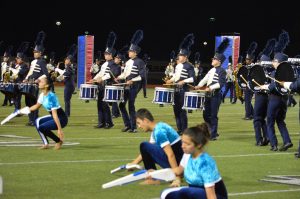A Need For Speed Skating
Senior Zachary Tidwell does a power slide, a move used in competitive inline speed skating. “My family has been really supportive of me skating, and hasn’t really been against it except for when I broke my leg,” Tidwell said. “They were just scared I was going to hurt my leg again when I got back [in the rink].”
November 7, 2017
A 2-year-old in roller skates stands on shaky legs, awkward and unbalanced on the pavement of his driveway while his parents hold his hands and try to steady him on his skates. 16 years later, he glides over the skating rink floor wearing inline speed skates and feeling like he is the only skater in the rink. Senior Zachary Tidwell is a competitive inline speed skater who has been involved with skating for the majority of his life.
“I’ve grown up around it my whole life,” Tidwell said. “[My parents] put me on quads because they’re a lot better for kids who don’t know how to skate and to get your balance. I begged them to put me on rollerblades because all the cool kids were on them. The elementary school I went to is right next to [Champions Rollerworld], and we had rollerskating parties. The whole school would go there, and everybody started realizing that I was really good.”
According to Tidwell, he began competitive skating when he was 12 years old because the owners of Champions Rollerworld are family friends.
“My stepdad’s best friend was a speed skater who skated with [Olympic speed skater] Chad Hedrick,” Tidwell said. “He trained at the rink and is the owner’s son.”
Tidwell is one of 15 skaters on the Skate Champions team at Champions Rollerworld.
“Being on a team is kind of like having a second family,” Tidwell said. “Before or after a meet, we would all go to a restaurant and eat, hangout and just talk. It was a lot of fun.”
According to fellow skater Kaeley Clarke, Tidwell loves competition and “showing off.”
“Inline speed skating has made him stronger and gain incredible coordination,” Clarke said. “He’s very fast, reaching speeds up to 45 mph on smooth concrete pavement.”
According to Tidwell, his favorite thing about competitive skating is the diversity of the sport.
“There’s speed skating for people who want to go fast,” Tidwell said. “That’s definitely me. There’s also trick skating where you freestyle skate. I try to mix in trick skating for fun. There is also jam skating, which isn’t doing tricks on skates like freestyle. It’s more like a group together jamming to music.”
Tidwell practices three to four days a week in the rink and outdoors for his skating competitions.
“During the beginning, we do off-skates,” Tidwell said. “We run around the track, warm up and do a core workout. After that, we’ll put on skates and start doing a relay-race, sprints, starts or circle drills. Our coach actually skates with us, so he knows how we’re feeling and how tired we are. We’ll do a whole drill, and he’ll be like ‘I’m dead, too, let’s go take a break.’”
According to Tidwell, his dad also helps him prepare for competitions.
“Outside of skating, my dad pushes me,” Tidwell said. “He’d be like, ‘We’re going to do 10 miles today. I’m going to time you on each mile.You need to go 2.75 minutes for this mile and go faster this one.’ He would get me used to going this fast and that fast.”
Skating competitions consist of multiple events, including timed races and relay races where each skater is separated by age group, or ranks. When an event does not have enough participants, skaters have the option of competing against a higher or lower rank.
“The organizers of the competition do warmups for each group,” Tidwell said. “Then, they’ll have different race events for each group. The higher you are, the more laps you do. Sometimes there aren’t enough people for [relays], so you have to challenge up or challenge down. I definitely challenge up.”
Most participants in competitive skating compete individually but still represent their skating team.
“Rollerblading is a one-on-one, personal sport, so you have a lot of people cheering on one team or one person,” senior Cameron Marlowe said. “There were a lot more people than I thought would be into rollerblading.. It was a very intense, high-energy [event].”
According to Clarke, the most impressive thing Tidwell had done at a competition was jump over a fallen teammate in the middle of a race.
“Zach has done many great things while skating,” Clarke said. “But one of the most impressive is when, mid-race, one of the other skaters lost a frame, and Zach jumped over the person and landed while continuing to skate. It was amazing.”
Later at the same competition, Tidwell broke his left tibia. This injury resulted in a trip to the ER and later the hospital, where Tidwell had a titanium rod inserted in his leg.
“A normal rink has walls as borders, but this rink had railings,” Tidwell said. “The corners [of the rink] were covered, but the straightaway wasn’t covered up with wood. The last lap of the race [was] this perfect setting: I just passed the guy that was in first, and now I’m first. [I went] up to that straightaway, went out a little too much and spun and flipped. I didn’t know [my leg] was broken at first. I thought it was just bruised because they wouldn’t let me look at my leg. I tried to take a step, and bone [stuck] out of my leg.”
According to Tidwell, he wants to try speed skating in the future.
“I want to join ice speed skating to try to make it to the Olympics,” Tidwell said. “Eventually I might begin competing in ice speed skating if I enjoy it as much as inline.”



![Senior Zachary Tidwell does a power slide, a move used in competitive inline speed skating. “My family has been really supportive of me skating, and hasn’t really been against it except for when I broke my leg,” Tidwell said. “They were just scared I was going to hurt my leg again when I got back [in the rink].”](https://kclegacypress.com/wp-content/uploads/2017/11/zach-3.0-900x571.png)




